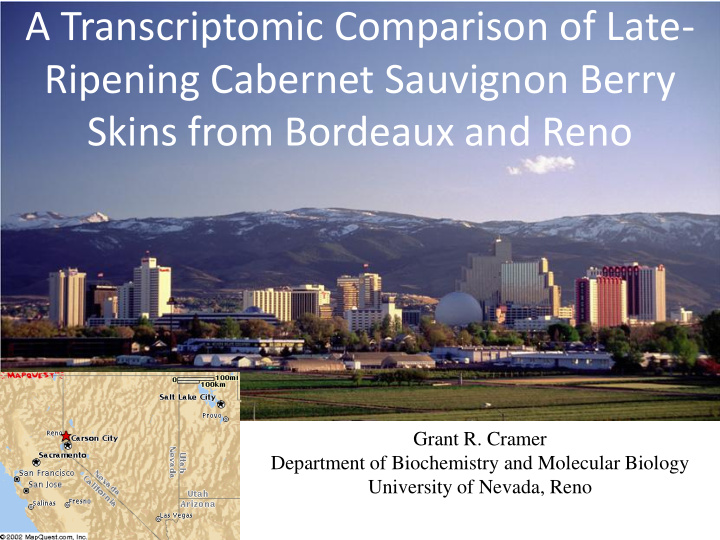



A Transcriptomic Comparison of Late- Ripening Cabernet Sauvignon Berry Skins from Bordeaux and Reno Grant R. Cramer Department of Biochemistry and Molecular Biology University of Nevada, Reno
Talk Outline • Experimental conditions • Transcriptomic analysis and results • Conclusions
Reno and Bordeaux Experimental Conditions Grapes harvested at 4 different °Brix levels at physiological maturity Environmental Variable BOD (2013) RNO (2012) Elevation (m) 25 1,373 Average Daily Solar Radiation (kW-hr m -2 ) 1.17 5.86 Day length Starting Harvest Date 12:25:36 12:38:34 Day length Ending Harvest Date 11:20:57 11:57:37 Maximum Temperature Starting Harvest Date 19 30.5 Minimum Temperature Starting Harvest Date 13 13.9 Maximum Temperature Ending Harvest Date 18 27.8 Minimum Temperature Ending Harvest Date (°C) 11 6.7 Ave September Maximum Temperature (°C) 23.9 30.2 Ave September Minimum Temperature (°C) 13.9 10.2 Latitude 44° 47’23.83’’ N 39° 52’96’’ N Longitude 0° 34’39.3’’ W 119° 81’38’’ W RNA-seq analysis of September Precipitation (mm) 65.5 2.03 berry skins using Illumina technology Average Monthly Relative Humidity (%) 74 34 Soil Type Gravelly soil Sandy Loam Soil pH 6.2 6.7 Root stock SO4 Own-rooted
Experimental Design • Three experimental replicates collected for berry skins at 4° Brix levels at or near physiological maturity for grapes of the respective location • BOD = 19.5, 20.5, 21.5, and 22.5 °Brix • RNO = 20, 22, 24 and 26 °Brix
Transcriptomic Method • 50 bp Illumina reads • Read alignment using the V2 assembly of the PN40024 Vitis vinifera reference genome • Transcripts per million (TPM) calculated using Salmon • Differentially expressed genes (DEGs) determined using DESeq2 • Gene Set Enrichment Analysis (GSEA) performed with BinGO
Recommend
More recommend